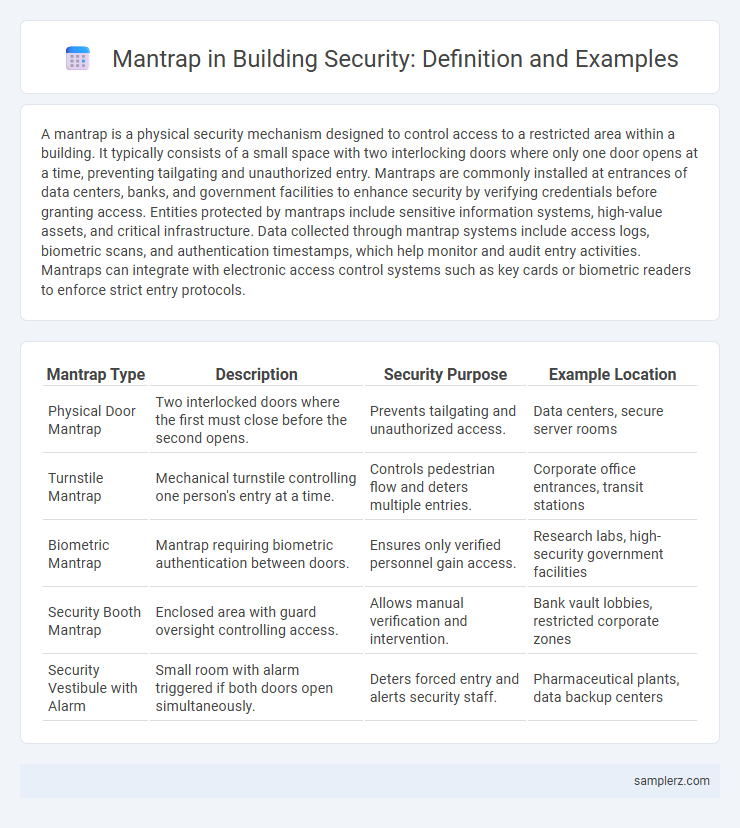A mantrap is a physical security mechanism designed to control access to a restricted area within a building. It typically consists of a small space with two interlocking doors where only one door opens at a time, preventing tailgating and unauthorized entry. Mantraps are commonly installed at entrances of data centers, banks, and government facilities to enhance security by verifying credentials before granting access. Entities protected by mantraps include sensitive information systems, high-value assets, and critical infrastructure. Data collected through mantrap systems include access logs, biometric scans, and authentication timestamps, which help monitor and audit entry activities. Mantraps can integrate with electronic access control systems such as key cards or biometric readers to enforce strict entry protocols.
Table of Comparison
| Mantrap Type | Description | Security Purpose | Example Location |
|---|---|---|---|
| Physical Door Mantrap | Two interlocked doors where the first must close before the second opens. | Prevents tailgating and unauthorized access. | Data centers, secure server rooms |
| Turnstile Mantrap | Mechanical turnstile controlling one person's entry at a time. | Controls pedestrian flow and deters multiple entries. | Corporate office entrances, transit stations |
| Biometric Mantrap | Mantrap requiring biometric authentication between doors. | Ensures only verified personnel gain access. | Research labs, high-security government facilities |
| Security Booth Mantrap | Enclosed area with guard oversight controlling access. | Allows manual verification and intervention. | Bank vault lobbies, restricted corporate zones |
| Security Vestibule with Alarm | Small room with alarm triggered if both doors open simultaneously. | Deters forced entry and alerts security staff. | Pharmaceutical plants, data backup centers |
Understanding Mantraps: Essential Elements in Building Security
Mantraps are controlled entry systems designed to prevent tailgating by isolating individuals between two interlocking doors within a secure building access point. Essential elements of mantraps include biometric authentication, anti-passback mechanisms, and reinforced barriers to ensure only authorized personnel gain entry. Integrating mantraps with access control systems and surveillance enhances overall security by verifying identity and controlling physical access effectively.
How Mantraps Enhance Physical Access Control
Mantraps enhance physical access control by creating a secure vestibule that requires authentication in two separate stages before granting access to sensitive areas. This dual-door system prevents tailgating and unauthorized entry by isolating individuals in a controlled space where security personnel or biometric systems verify identities. Implemented in high-security buildings such as data centers and government facilities, mantraps significantly reduce the risk of breaches and enhance overall site security.
Real-World Mantrap Installations in Corporate Offices
Real-world mantrap installations in corporate offices often feature dual-door systems equipped with biometric scanners and proximity card readers to regulate access strictly. These controlled entry points create a secure vestibule where only one door opens at a time, preventing tailgating and unauthorized access. Leading corporations implement this technology to protect sensitive areas like data centers and executive suites, reinforcing physical security protocols.
Banking Sector Security: Mantrap Implementation Case Studies
Mantrap implementation in the banking sector enhances security by creating controlled entry points that segregate unauthorized access from sensitive areas such as vaults and data centers. Case studies reveal that integrating biometric authentication and CCTV monitoring within these mantraps significantly reduces incidents of internal theft and unauthorized breaches. These systems enable real-time alerts and access logs, ensuring banks maintain stringent security compliance and protect critical assets effectively.
Integrating Mantraps with Biometric Authentication Systems
Integrating mantraps with biometric authentication systems enhances building security by ensuring only authorized individuals gain access to sensitive areas through dual verification methods such as fingerprint or iris recognition combined with controlled entry/exit chambers. This integration prevents tailgating and unauthorized entry by requiring biometric validation inside the mantrap before doors unlock sequentially. Advanced biometric mantraps reduce security breaches and elevate access control protocols in high-security facilities like data centers and research labs.
Mantraps in Data Centers: Preventing Unauthorized Access
Mantraps in data centers serve as critical security barriers that control and monitor personnel entry, significantly reducing the risk of unauthorized access to sensitive areas. These layered security enclosures typically consist of two interlocking doors where the first door must close before the second door opens, ensuring only authorized individuals pass through. By integrating biometric scanners and surveillance systems, mantraps enhance security protocols and protect valuable data infrastructure from physical breaches.
Government Facilities: Mantrap Design Examples
Government facilities often implement mantrap security systems featuring dual-door chambers that require identity verification before entry to restricted areas. Typical mantrap designs include biometric scanners, card readers, and intercom systems to ensure only authorized personnel gain access, enhancing control and minimizing unauthorized intrusion risks. Integration with surveillance systems and alarm triggers further secures sensitive government spaces against potential threats.
Key Features of High-Security Mantrap Solutions
High-security mantrap solutions in buildings incorporate biometric authentication, turnstile gates, and reinforced barriers to prevent tailgating and unauthorized access. These systems often include integrated access control software that logs entry and exit times for enhanced monitoring and audit trails. Advanced sensors and real-time alarm notifications ensure immediate response to security breaches, making mantraps a critical component in secure facility management.
Compliance and Regulations Involving Mantraps in Buildings
Mantraps in buildings must comply with fire safety and accessibility regulations, including NFPA 101 and ADA standards to ensure safe egress and disability access. Compliance with OSHA guidelines and local building codes is critical to prevent hazards such as entrapment or restricted evacuation during emergencies. Proper installation and maintenance also address privacy laws and security protocols by controlling access and minimizing unauthorized entry risks.
Future Trends: Smart Mantraps in Modern Architecture
Smart mantraps integrate AI-powered biometric scanners and real-time analytics to enhance access control in modern buildings. These advanced systems utilize IoT connectivity to monitor and respond to security breaches instantly while maintaining user convenience. Predictive algorithms enable proactive threat detection, revolutionizing physical security frameworks in contemporary architecture.

example of mantrap in building Infographic
 samplerz.com
samplerz.com